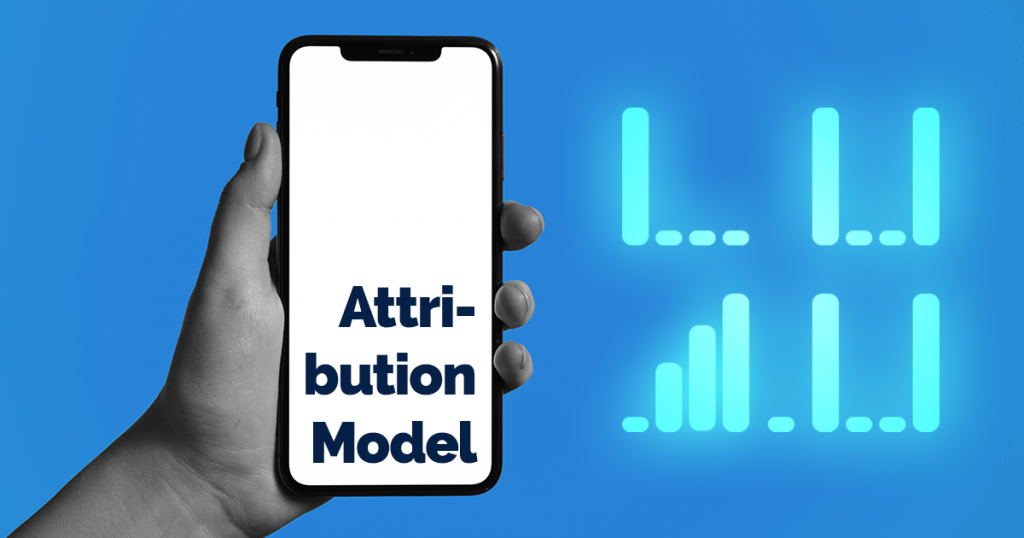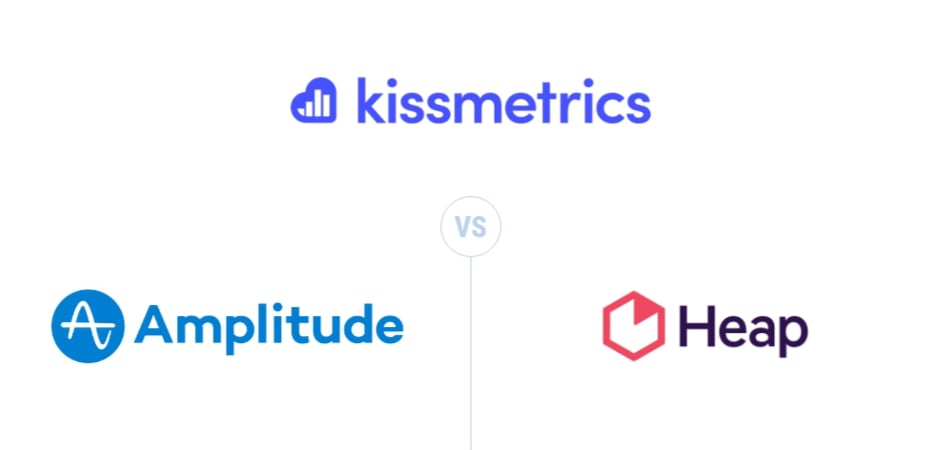If you are running Google Ads, understanding attribution models will help you prove ROI for your campaigns. An attribution model for Google Ads can provide you with a competitive edge since a lot of PPC advertisers and businesses don’t use it because it looks complicated (we promise, it isn’t that bad — and the benefits definitely outweigh the disadvantages).
Attribution models for Google Ads give you a lot of information about your target audience and conversions — information you wouldn’t otherwise find somewhere else. Basically, this will allow you to determine when and how users convert and what path they follow to conversion. Consequently, this will also help you boost your ROAS.
It is quite important to make sure you select the right attribution model — and that is precisely what we will teach you in this article! Read on to find out more.
What is a Google Ads Attribution Model?
Google defines an attribution model as a set of rules that determine how credit for conversion is distributed or assigned to different touchpoints. A potential customer moves from several touchpoints before conversion. On average, it takes 7 to 13+ touches to convert a visitor into a customer.
For example, a visitor saw a Facebook post, liked your page, then visited your website after seeing your ad, signed up for the lead magnet, and converted at the third autoresponder email from your end.
The customer, in this case, went through multiple touchpoints or channels including Facebook, Google ad, website, lead magnet, and email. How will you determine which channel led to the conversion and which one played the most important role in the whole conversion process?
This is what the attribution model is all about.
It helps you determine and attribute sales and conversions to the most appropriate channel/touchpoint. The path to purchase varies from customer to customer. Not all customers follow the same path, though, so you cannot mathematically predict (or analyze) the same path every time someone converts.
Google Ads lets you choose from a wide range of attribution models when setting up your campaigns. These include:
- Last click model
- First click model
- Linear model
- Time decay model
- Position based model
- Data driven model.
Why Is Google Ads Attribution Model Important?
Why is attribution modeling essential? Can’t you just assign all sales and conversions to a single touchpoint of your choice?
NO.
There are several reasons and benefits of using attribution models:
- The attribution model helps you identify the most crucial touchpoints that lead to conversions.
- It helps you measure campaign effectiveness and prove ROI based on the exact number of sales and conversions generated by a specific campaign.
- You get actionable data and insights into what really works for your target audience. You can hook this data into your buyer personas to improve targeting across all levels.
- It helps you save money as you can skip investing money on channels that lead to no or low conversions.
- You can optimize your conversion funnel by focusing on channels that work and removing barriers.
These are strong enough reasons to stick start using attribution models.
Google Ads Attribution Models
Google Ads offers you multiple attribution models to credit sales and conversions appropriately to the most suitable channel. What are different models that you can choose from and what does each mean, let’s find out:
1. Last Click Model
The last click attribution model gives all the credit to the last clicked ad. This means if a visitor saw your Google Ad, then found your website via a search engine, then subscribed to your email list, and finally converted via your website, this conversion will be credited to your website:
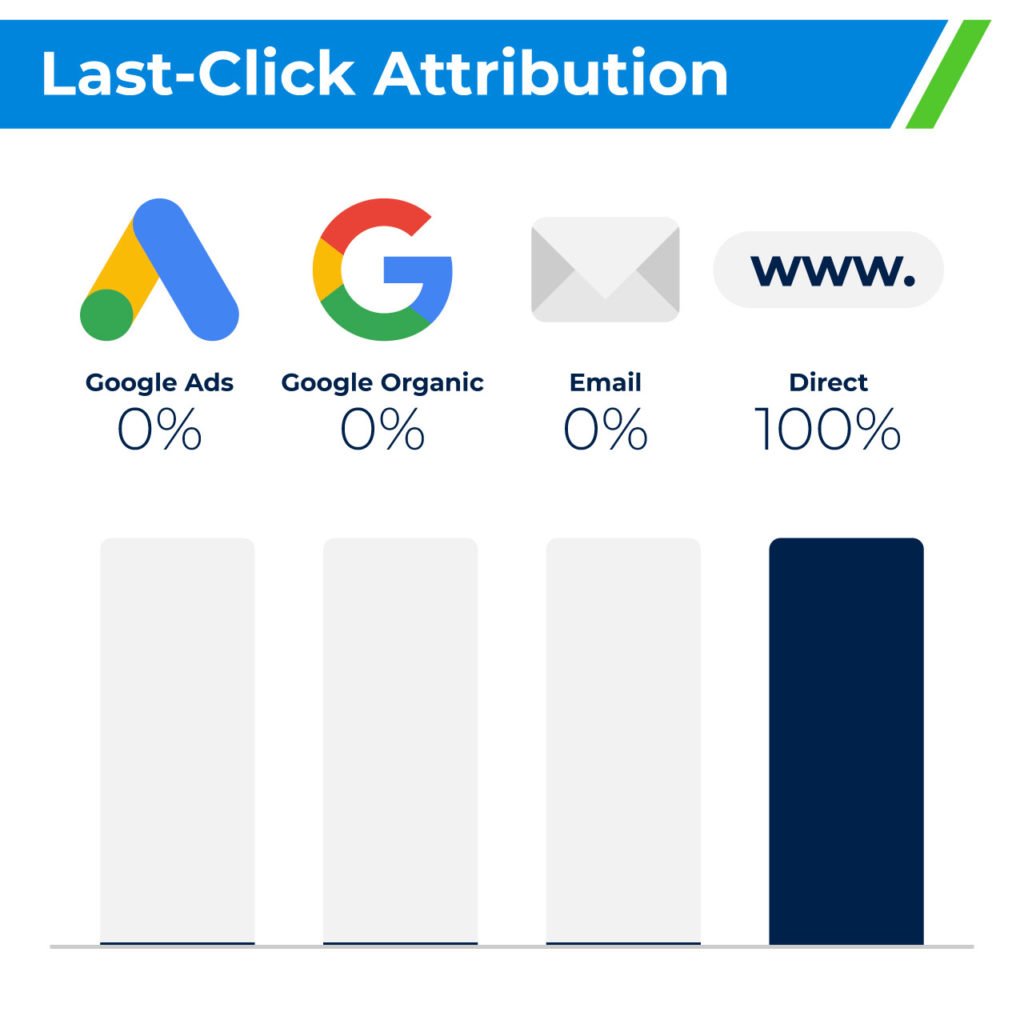
The last touchpoint or channel gets 100% credit for the conversion. This is the default attribution model in Google Ads.
Since it is the default attribution model in Google Ads, a lot of businesses simply stick with it to avoid complications. It seems to be the easiest model of them all and it makes it super easy to prove the ROI of your campaigns.
How?
Simply give credit to sales and conversions to the ads you are running.
But the last click attribution model doesn’t capture the full conversion path. By giving all the credit to the last touchpoint means you are ignoring the impact and value of the other touchpoints that played their role in the conversion.
A buyer doesn’t just see your ad, clicks it, and converts. This rarely happens. The path to conversion is non-linear and as said, you need a minimum of 7 touches to convert a visitor.
The last click doesn’t capture the full story.
2. First Click Model
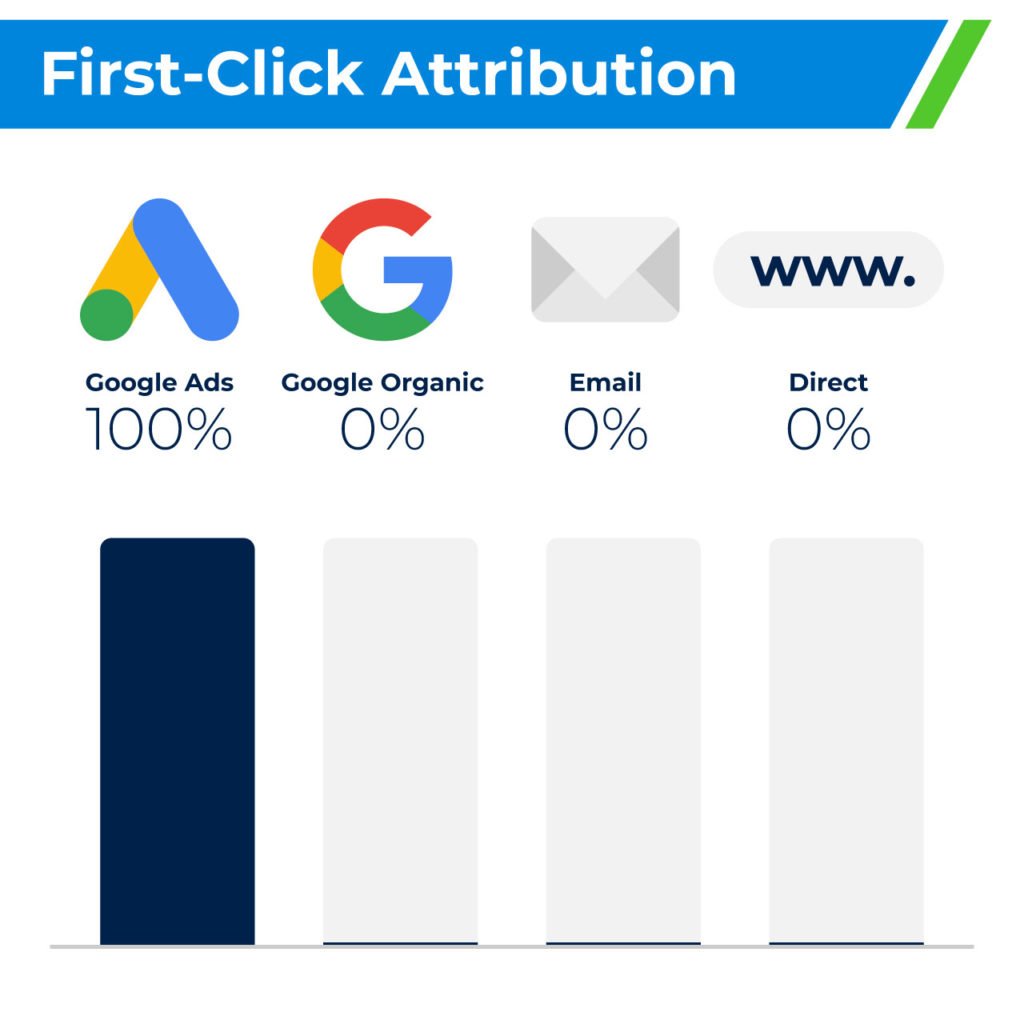
This is exactly the opposite of the last click attribution model. In this case, 100% of the credit is given to the first clicked ad and the remaining touchpoints don’t receive any credit.
The first click attribution model works great for awareness campaigns since it shows you that your ad, keyword, and channel worked in terms of engaging your target audience (and hence it is being clicked). So, if the objective of your Google Ads campaign is to improve brand awareness and it is aimed at targeting the top of the funnel audience, you must stick with the first click attribution model.
Why?
Because it will clearly tell you the keyword and ad that persuaded a potential buyer to click. This data is helpful in identifying top keywords, ad types, creatives, headlines, CTAs, and other variables that generate clicks.
However, tracking conversions and sales based on mere first clicks isn’t a good idea. If you’ll give full credit to the first click for all the conversions, you’ll ignore the other channels and touchpoints that played their role.
The first click model is, therefore, ideal for awareness campaigns but it doesn’t capture the full conversion path and doesn’t credit all the touches.
3. Linear Model
With the linear attribution model, the credit for conversion is equally distributed among all the touchpoints that a visitor goes through. If a potential buyer moved through three different channels before conversion, all three channels will get equal credit for the conversion:
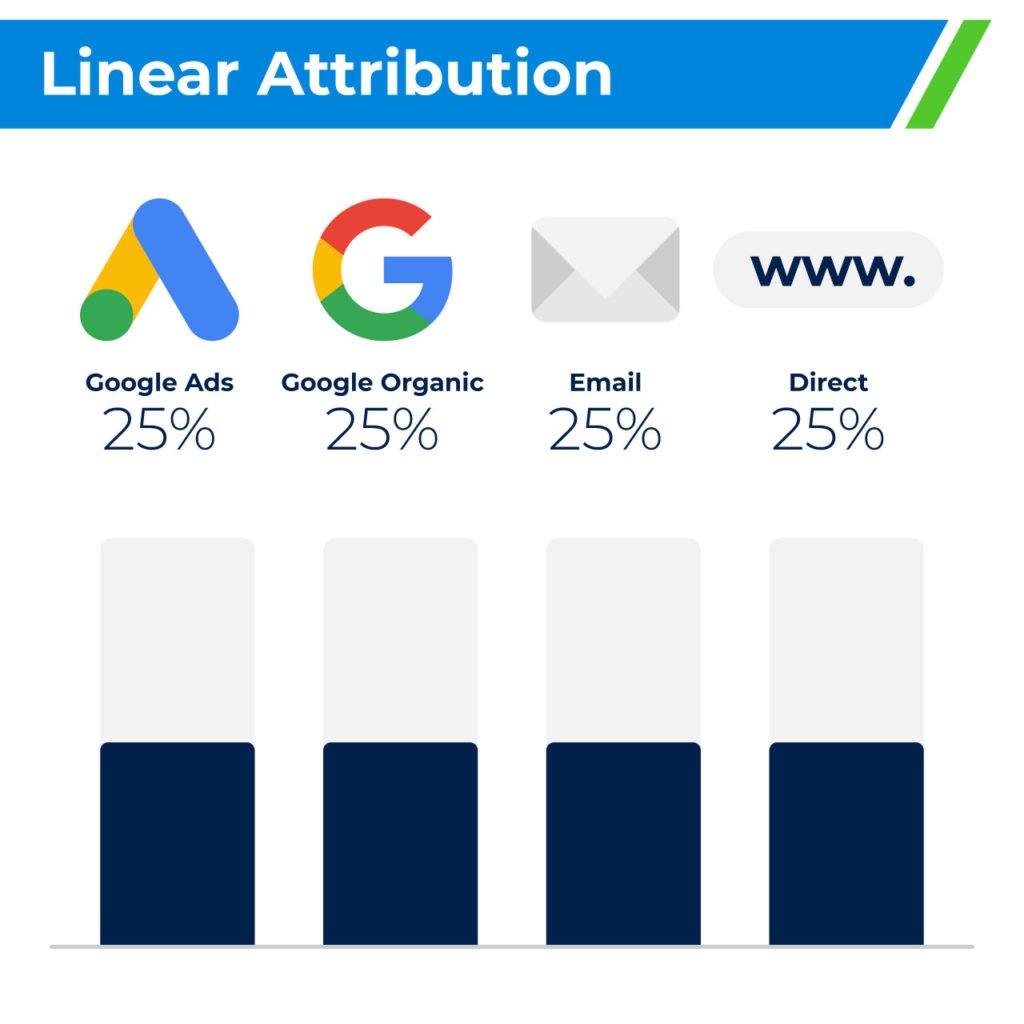
This attribution model is best to identify touchpoints, ads, keywords, and channels that contribute to the conversion. You’ll know what channels are working and this helps you optimize your ad budget.
If you have a long conversion path where users go through several touches before conversion, a linear path is most suitable. For example, if you are selling insurance, the linear attribution model will work best as a potential buyer will be contacted multiple times before conversion.
The best approach, in this case, is to give credit to all the channels equally.
4. Time Decay Model
It is similar to the linear attribution model since it gives credit to all the touchpoints. But with time decay attribution models for Google ads, the credit isn’t equally distributed rather it is skewed. The initial interactions receive less credit while interactions closer to conversion receive high credit:
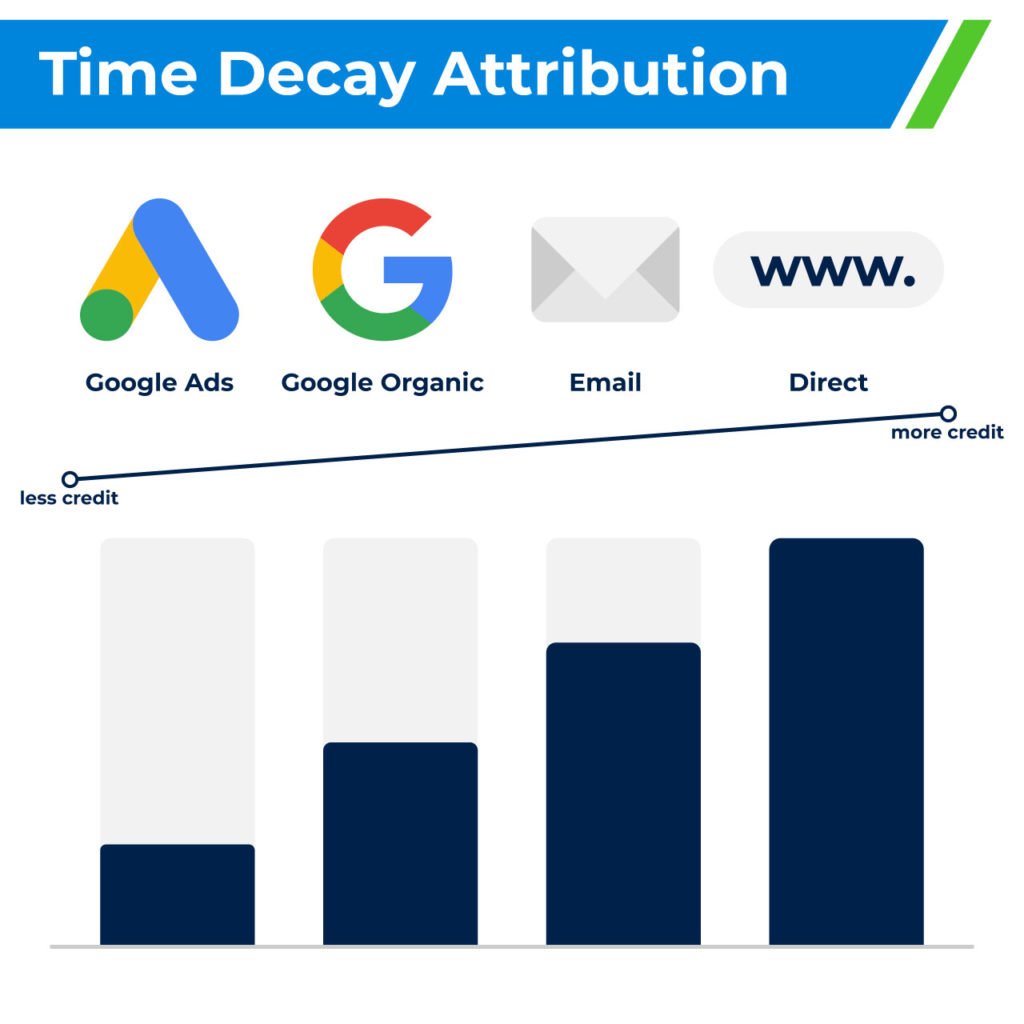
This makes sense because the influence of interaction increases with time.
If you have a complex and long conversion funnel where your sales team spends a lot of time nurturing leads, the time decay model suits you. The impact of interactions close to the conversion will naturally be higher than the initial interactions.
5. Position Based Model
Position based attribution model (also known as the U-Shaped model) prioritizes the first and the last touchpoints and gives them 40% of credit each. The remaining central interactions receive 20% of credit:
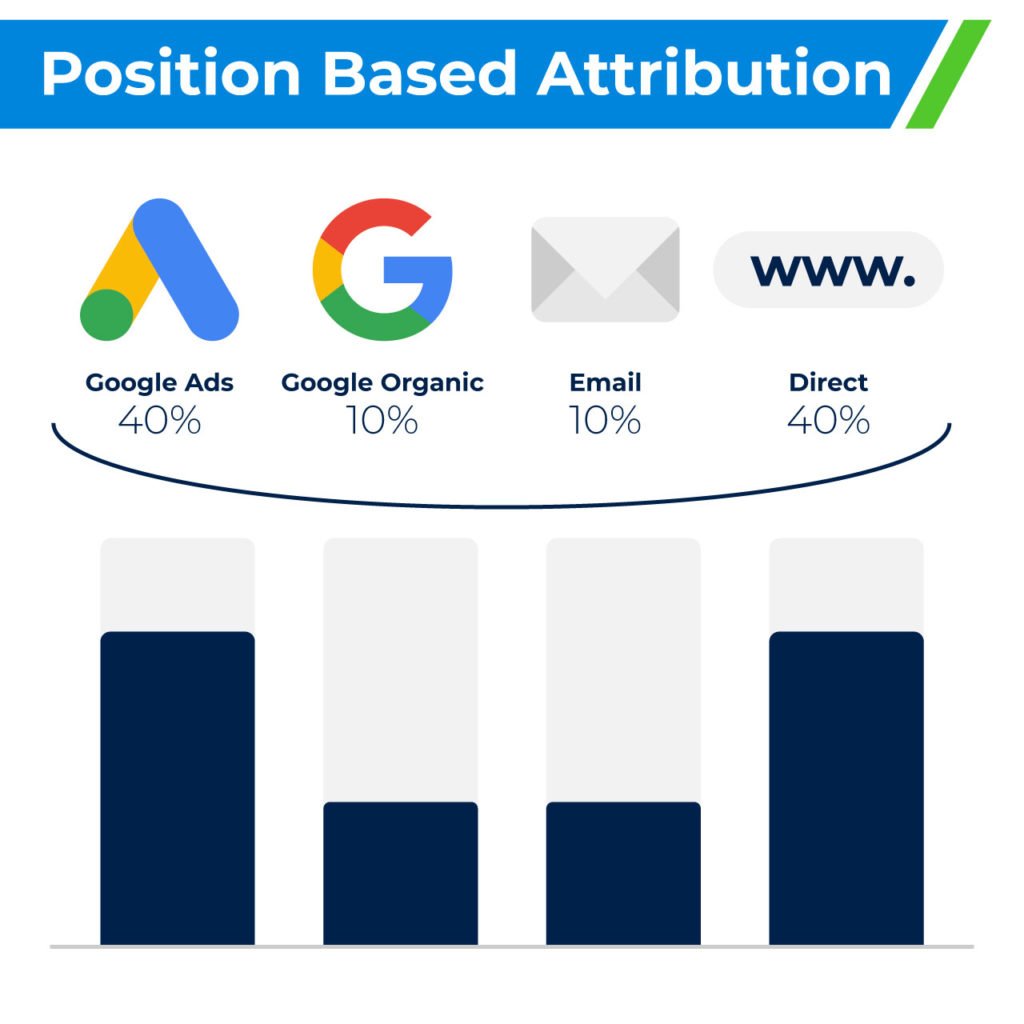
This model works best in identifying the first ad that gets user attention and the final interaction that led the conversion. If you are running a Google Ads campaign, you’ll get to know the ads that generated the interaction. You can then use the right keywords and ad combinations to boost conversions.
It is clearly focused on awareness and conversion.
6. Data Driven Model
This Google Ads attribution model uses machine learning to automatically distribute credit among all the touchpoints based on the influence of the keyword and ad.
Google identifies the most influential touchpoints in your funnel based on your account’s historical data. It then gives to the most influential keyword and ad based on its impact on conversion.
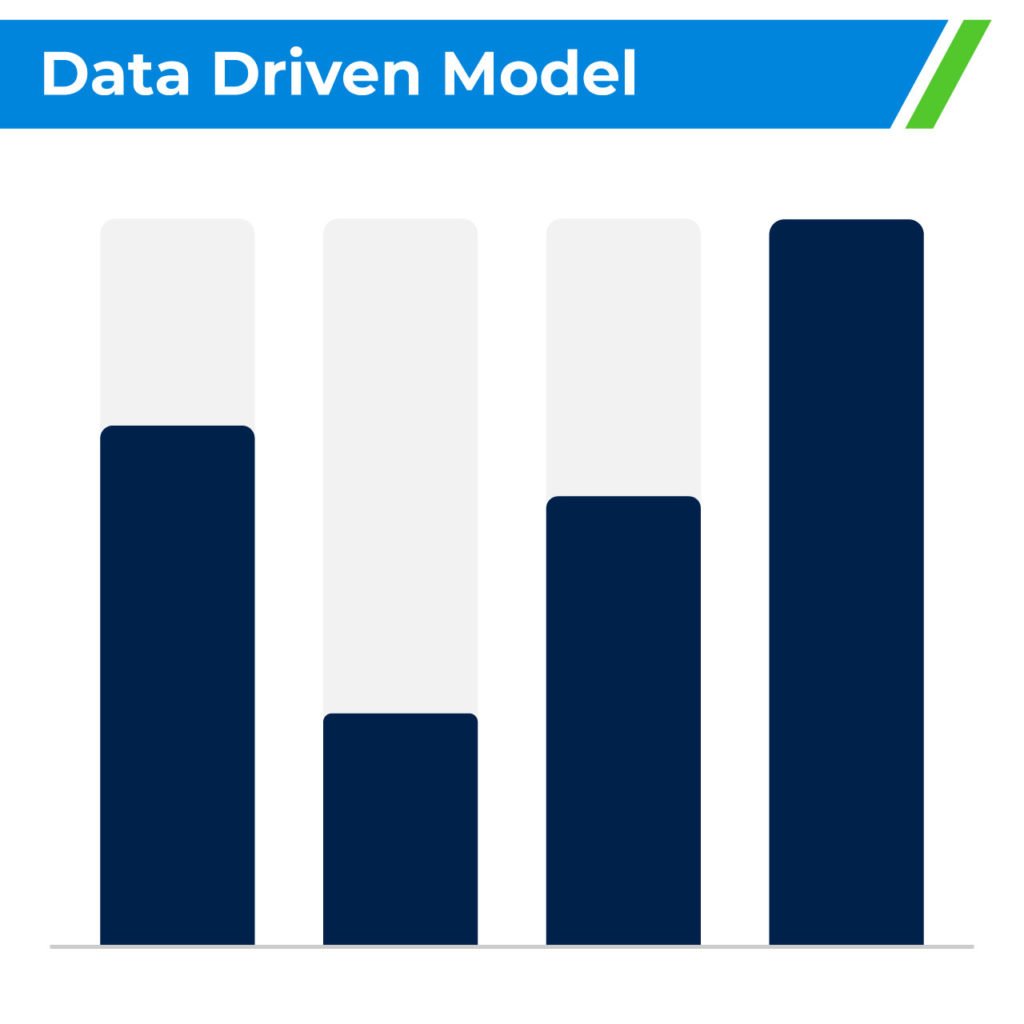
If you want to use data driven model, you must meet the following requirements:
- 15,000 clicks and 600 conversions in 30 days
- 10,000 clicks and 400 conversions each 30 days to continue using the attribution model.
This means you must have a fairly decent advertising budget per month to generate this number of clicks and conversions. If your account doesn’t generate this many clicks and conversions, you’ll not have access to the data driven attribution model.
How to Choose the Best Google Ads Attribution Model for Your Business
So, what’s the best Google Ads attribution model for your business?
Well, it depends on several factors such as your business model, niche, your advertising goals, and preferences. Each model has its pros and cons. If you are looking for a single best attribution model, that’s none other than a data driven model.
It is fully automated and works great.
If you have access to it, you must use it.
However, if you don’t have access to it yet, you’ll have to choose from others. Here are a few tips to help you select the most appropriate attribution model for your business:
- Use the last click attribution model if you are running a simple Google Ads campaign without any remarketing campaigns. It works best to find the ad that generated the conversion.
- Use the first click model if your ad is targeting the top of the funnel and your ad campaign objective is to boost awareness. This model will show you the most powerful ad and keywords that generated interaction and click.
- Use the linear model when you have a lengthy and complicated conversion funnel and it is hard to identify the weightage of each interaction in conversion. This model is also helpful in identifying all the interactions in the conversion process.
- Use the time decay model if you have a long conversion and sales process with a focus on lead nurturing. If you have to spend time on lead nurturing (e.g. consultation business), the time decay model works best.
- Use the position-based model if you want to focus on ads and keywords that generate initial awareness and conversion.
Again, there isn’t any right or wrong Google Ads attribution model. In the end, you have to select the most appropriate model based on your requirements and preferences.
